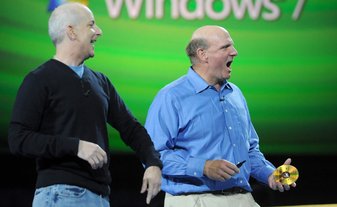A slide in the sales of Microsoft’s flagship Windows product and a tangle with European regulators have cut into the bonuses for Steve Ballmer, Microsoft’s chief executive, and Steven Sinofsky, president of the company’s Windows division.
 Erik S. Lesser/Microsoft, via Associated Press Steve Ballmer, Microsoft’s chief executive, right, and Steven Sinofsky, president of the company’s Windows division, in 2009.
Erik S. Lesser/Microsoft, via Associated Press Steve Ballmer, Microsoft’s chief executive, right, and Steven Sinofsky, president of the company’s Windows division, in 2009.
According to an annual proxy filing with securities regulators on Tuesday, Microsoft’s board decided to award Mr. Ballmer less than half the total bonus he was eligible for during the company’s most recent fiscal year, which ended June 30. The board awarded Mr. Sinofsky 60 percent of the bonus for which he was eligible.
Although other senior Microsoft executives also fell short of the total bonuses they could have received, the board penalized Mr. Ballmer and Mr. Sinofsky the most, and for similar reasons. Among the negative factors that weighed on the calculation of Mr. Ballmer’s bonus, according to the company’s filing, was “modest growth” in the market share of the Windows Phone operating system; a 3 percent decline in revenue for the company’s Windows division; “slower than planned progress” in its Internet unit; and the failure of the Windows division to live up to a 2009 commitment with the European Commission to offer a screen on its operating system that allows users to install an alternative Web browser.
The board similarly penalized Mr. Sinofsky for the decline in Windows revenue and the browser snafu in Europe.
Under the company’s compensation rules, Mr. Ballmer is eligible for a cash bonus equivalent to 200 percent of his base salary, which was $685,000. Instead, he received roughly 91 percent, or $620,000. Like other senior Microsoft executives, Mr. Sinofsky was eligible to receive 150 percent of his target bonus. Instead, he received 90 percent, or $7.65 million.
Mr. Ballmer’s total compensation is far lower than that of other senior Microsoft executives, at his request. He is a significant holder of Microsoft’s stock, with more than 333 million shares worth more than $10 billion. He receives only cash as a bonus, while other executives receive a mix of cash and stock.
This is not the first time the two men have fallen short of the total bonuses for which they were eligible. In the previous year, Mr. Sinofsky received 90 percent, rather than the 150 percent the board could have awarded him. Mr. Ballmer, meanwhile, received 100 percent of his target bonus, or exactly half the amount he could have received, a slightly better performance than in the most recent fiscal year.
Separately, Microsoft announced that one prominent member of its board, Reed Hastings, the chief executive of Netflix, would not stand for re-election at the company’s coming shareholder meeting. Mr. Hastings, who joined the Microsoft board in 2007, said he had decided to reduce the number of boards he serves on so he can concentrate on Netflix and various education initiatives. He serves on the boards of Facebook and the California Charter Schools Association, among others.
Article source: http://bits.blogs.nytimes.com/2012/10/09/missteps-curb-microsoft-bonuses-for-ballmer-and-sinofsky/?partner=rss&emc=rss